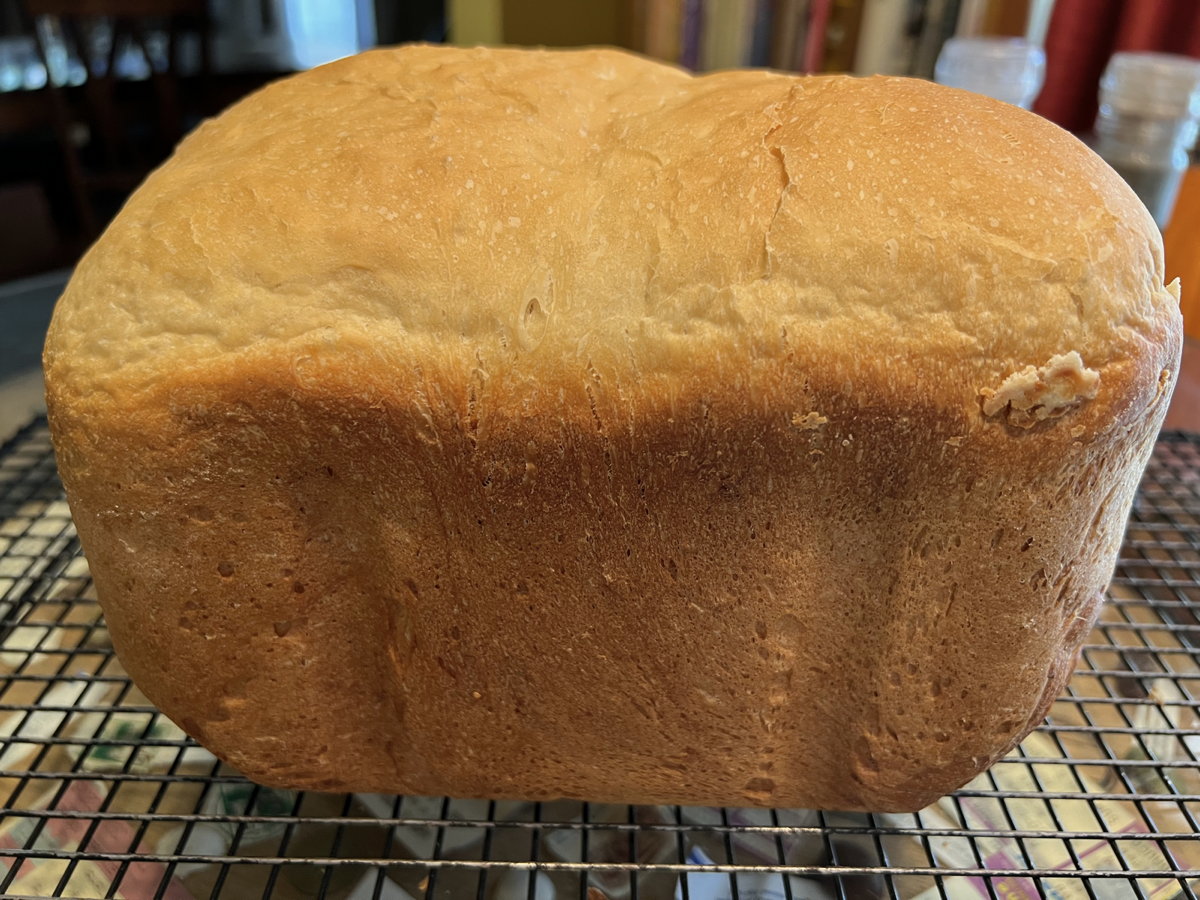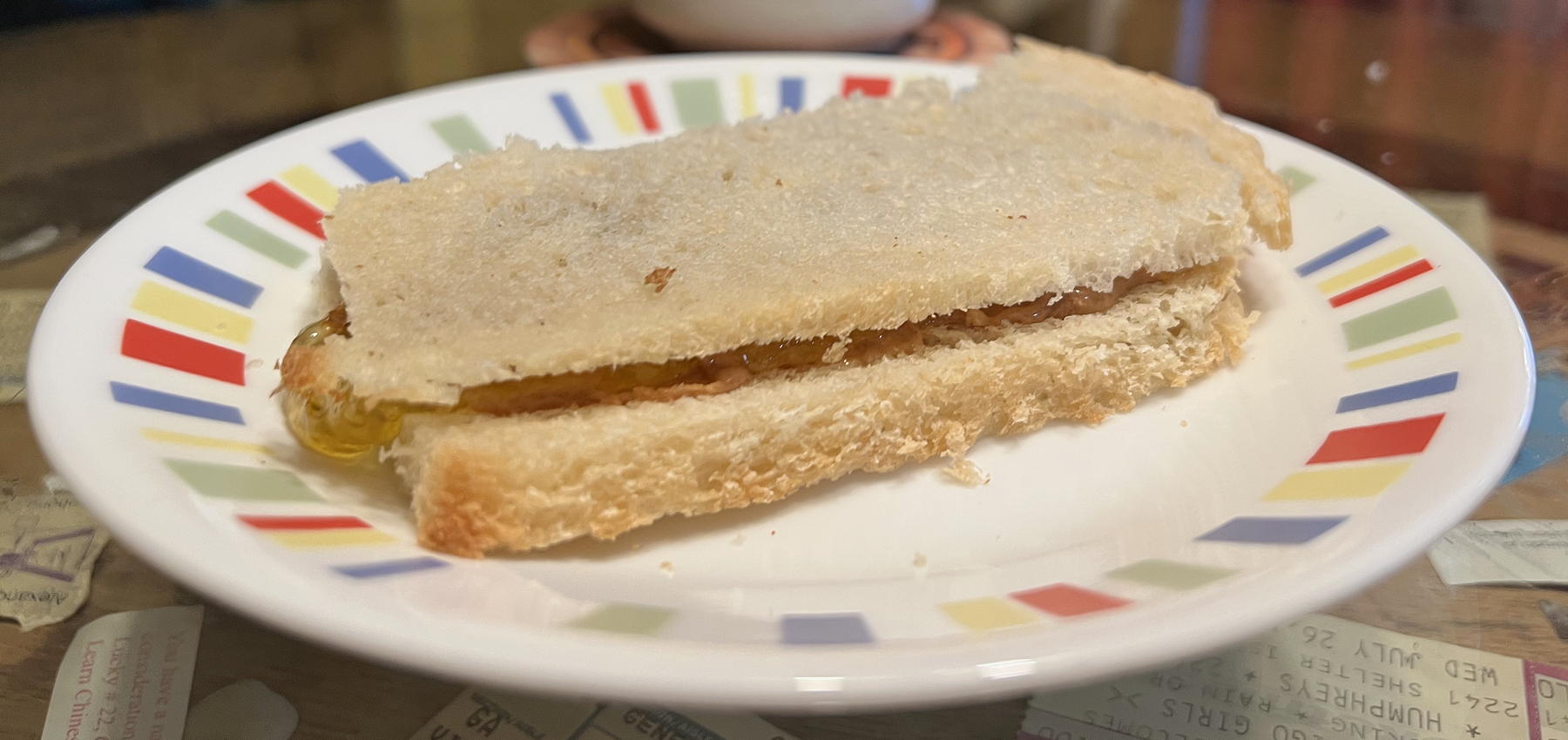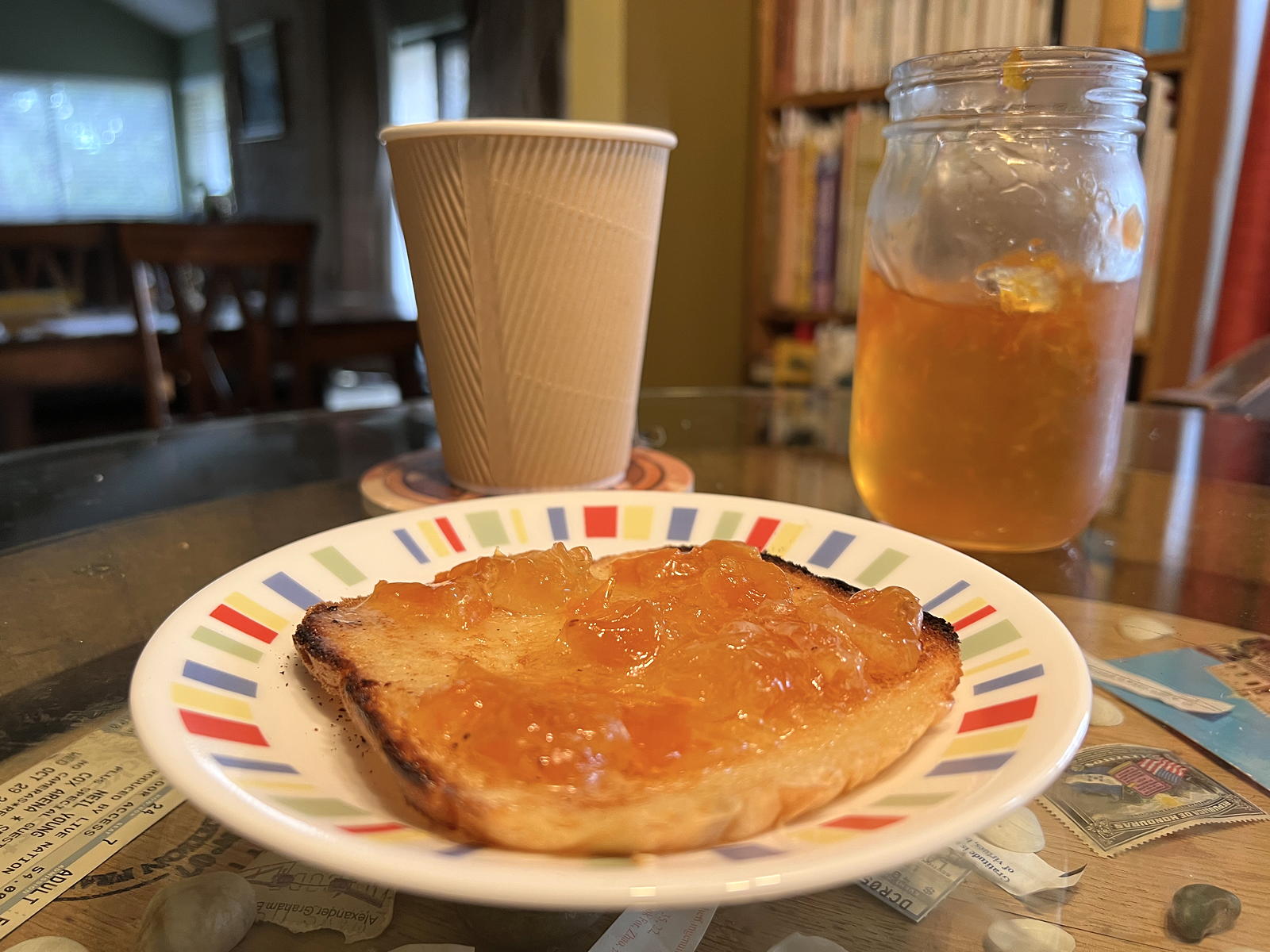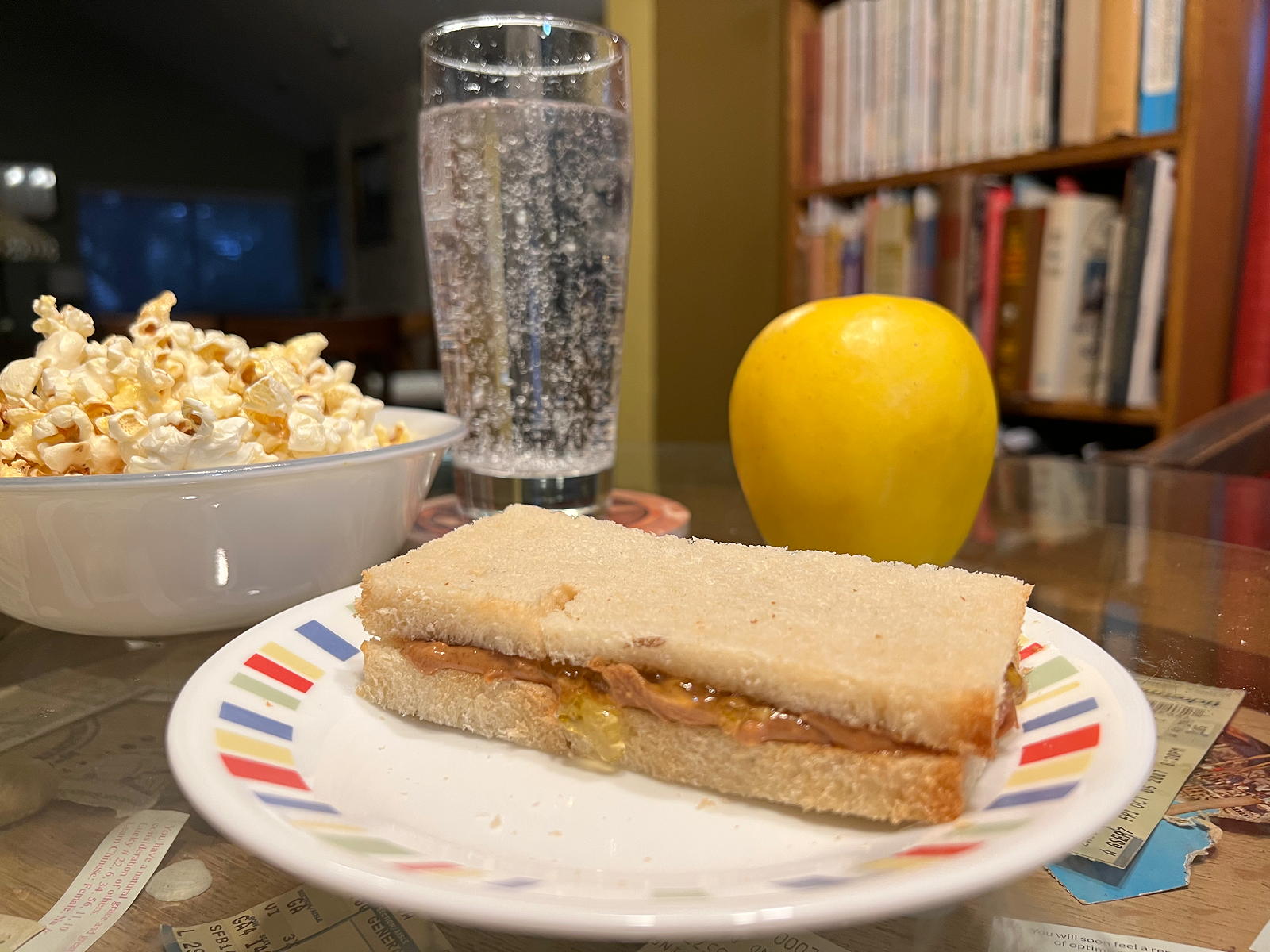Eddie Doucette’s Potato Bread

Friday is National Sandwich Day. If you’re having a backyard barbecue or picnic, or just making sandwiches for lunch, consider making this light, flavorful potato bread to help celebrate the occasion.
I found this recipe in the April 4, 1967, Alton Evening Telegraph. It was part of a media blitz for Eddie Doucette’s “French Cooking Can Be Fun” show at Alton’s Monticello College. There was a lot of cool stuff in there, which you can see in Tempt Them with Tastier Foods. Tempt Them is a free download, and it’s also available in print if you (as I do) prefer having a book in the kitchen.
I can’t overemphasize how much fun Eddie Doucette’s recipes are, how much joy he takes in spreading the message that “cooking can be fun”.
The article that featured this recipe is “You Can Have Fun With Yeast”. It’s a typically upbeat and encouraging article from Chef Doucette. He starts off quoting his mother about the importance of bread, talks about the nostalgia, drama, and romance of working with yeast, and ends with a positive affirmation about the pleasures of home cooking:
With our modern mode of cooking and baking it is a pleasure to produce sumptuous light taste-provoking baked goods, whether it be for your own table, a surprise gift for a dear friend, a church social or what-have-you, I’m certain you’ll find you can have “Fun With Yeast.”
It’s an upbeat sentiment that others can only see pessimistically.
When I was growing up nobody could show me how to bake bread—and it’s only gotten worse. It seems such a shame that as a culture we don’t teach our children about the basic things in life—bread making, gardening, sewing—and the value of work. At some point, all these things got to be beneath our dignity. If you can’t work with your hands, you lose the richness of your life and the sense of being productive. — Edward Espe Brown (Flour Power)
Doucette’s unstated motto is, why complain that people don’t bake, when you can instead show people the joy of baking? That cooking can be and is fun!

Potato Bread
Servings: 10
Preparation Time: 5 hours
Eddie Doucette
Tempt Them with Tastier Foods: An Eddie Doucette Recipe Collection
Ingredients
- 1 cup milk
- 2 tbsp shortening
- ½ cup mashed potatoes
- 2 tbsp sugar
- 2 tsp salt
- ½ cup cold water
- 1 packet yeast
- 4-½ cups sifted flour
Steps
- Put the milk, mashed potato, sugar, salt, and shortening in a sauce pan.
- Bring to the scalding point (165°) to melt the shortening.
- Remove from heat, add the water, and cool to lukewarm.
- Transfer to a large mixing bowl and dissolve the yeast into the lukewarm mixture.
- Gradually add the flour, beating with a spoon.
- When too stiff to stir with a spoon, knead in the remaining flour until the dough is smooth and elastic.
- Let rise in the same bowl at room temperature, covered with a damp cloth, until doubled in bulk (about 1-½ hours).
- Punch down and let rise again for an hour.
- Turn dough onto floured board, cut in half, and shape into two loaves. Place into two well-greased 9x5x3 bread pans.
- Cover and let rise again until doubled.
- Dust lightly with flour and bake for one hour at 350°.

Homemade English marmalade on potato bread toast is a great way to start the day.
Doucette notes in his introduction to the article that you can brush the top of the loaves with butter when they come out of the oven for “a tender shiny crust” or you can brush the crust with warm water for a harder crust.
He also noted that you can use either mashed potatoes from real potatoes, or mashed potatoes from an instant mix. I’ve never tried the latter. Not that it isn’t a good idea, but when I make mashed potatoes from a mix, I usually make exactly what I need. Generally the point of a recipe like this is to use leftovers. That said, it’s good enough you might want to make it even when you don’t have leftover mashed potatoes. At that point a mix could come in handy.

A peanut butter and jelly sandwich with popcorn and an apple is a great supper! Especially with this potato bread.
There’s a similar recipe in Ruth Bakalar’s 1969 Complete Potato Cookbook that makes just that assumption. Her recipe assumes you’re starting from a potato instead of from mashed potato. Instead of ½ cup mashed potato, it calls for taking a potato and boiling it, and then adding enough milk to reach 1-½ cups. This matches the ½ cup potato and 1 cup milk in Doucette’s recipe.
Normally when I post a bread recipe, I post it for a bread machine. But because Doucette’s instructions are very practical and useful, I’ve given his original instructions, modified only for modern yeast. I’ve always made this bread in a bread machine, however. I make it pretty much exactly following Doucette’s instructions for everything except the flour and yeast. I make the potato-liquid mixture (using lard for the shortening), add the cold water to help cool it to lukewarm, put it in the bread machine, and then put exactly 19 ounces of sifted flour on top. Then, as always, I make an indentation on top and put the 2-¼ teaspoons of yeast into the indentation. It works perfectly.
I bake this bread using the settings for a two-pound loaf of white bread with a light crust. Despite making it in a single pan in the bread machine, I do not make a half recipe; my bread maker makes larger loaves. Your mileage may vary.
I have not yet tried making it without peeling the potato. I’m not sure how peel would interact with the automatic kneading of a bread machine. If you’re making by hand, of course, you don’t have to worry about that.
This is a great all-purpose bread. I’ve used it with barbecue, for sandwiches of all kinds—including using a 1950s meat-olive spread—and especially with peanut butter and jam.
It’s great in the morning as toast, and at lunch or supper as an untoasted sandwich. Like potatoes themselves, it’s great toasted and buttered.
I made the English Marmalade in the photo from Jo Ann Shirley’s wonderful Wonderful Ways to Prepare Preserves. It’s on page 49 if you want to check it out. If you’ve never canned jams or jellies before, that book is a very good introduction to it.
In response to A home-cooking handful from Eddie Doucette: A glimpse at a long-lost 1954 Chicagoland television cooking show, including recipes. Some of them require creative interpretation.
- A 1950 recipe calendar for 2023
- In October, a friend gave me this cool calendar of recipes from 1950. It turns out, 1950 is the same as 2023, right down to the date of Easter. Print it out and hang it if you wish, and happy New Year!
- Review: The Complete Potato Cookbook: Jerry Stratton at Jerry@Goodreads
- Potato stew, bread, scalloped, hash. Ruth Bakalar has you covered if you enjoy potatoes.
- Tempt Them with Tastier Foods: An Eddie Doucette Recipe Collection
- When I get locked into a serious recipe collection, the tendency is to take it as far as I can. You can benefit from my obsession with this collection of wonderful recipes from the fifties and sixties “files of Eddie Doucette”, television personality and IGA chef.
- Wonderful Ways to Prepare Preserves: Jo Ann Shirley at Internet Archive
- This was my first introduction to canning. It excels with interesting ideas for recipes you’ll want to make even if you don’t have too much of any particular fruit or vegetable and need to preserve it. The English Marmalade and the Oranges and Pears Grand Marnier are especially good.
More bread
- Club recipe archive
- Every Sunday, the Padgett Sunday Supper Club features one special recipe. These are the recipes that have been featured on past Sundays.
- The reincarnation of the B6000C bread machine
- The Black & Decker B6000C rises again. Pun intended. The West Bend 47413 three-pound breadmaker is a nearly-exact duplicate of the late, great B6000C.
- Padgett Sunday Supper Club
- Dedicated to the preservation of vintage recipes.
- The Donna Rathmell German Bread Machine Cookbook collection
- Donna Rathmell German’s little cookbooks, from the Nitty Gritty collection, are a great companion to your bread machine and a great lesson in using bread machines to make bread.
- Sealing the bread slice guide
- Charles the Simple suggested using “common mineral oil” to seal the wood. It works!
- Eight more pages with the topic bread, and other related pages
More Eddie Doucette
- Tempt Them with Tastier Foods: Second Printing
- The second printing of Tempt Them with Tastier Foods contains several newly-discovered Eddie Doucette recipes, as well as an interview with the chef’s son, Eddie Doucette III.
- Oktoberfest Sauerkraut for Potato Day
- This simple sauerkraut casserole turns into an amazing National Potato Day treat when topped with mashed potato.
- Eddie Doucette recipe sampler
- Despite their occasional weirdness, I’ve yet to try a recipe that didn’t turn out at least pretty good. Some are amazing.
- Tempt Them with Tastier Foods: An Eddie Doucette Recipe Collection
- When I get locked into a serious recipe collection, the tendency is to take it as far as I can. You can benefit from my obsession with this collection of wonderful recipes from the fifties and sixties “files of Eddie Doucette”, television personality and IGA chef.
- A home-cooking handful from Eddie Doucette
- A glimpse at a long-lost 1954 Chicagoland television cooking show, including recipes. Some of them require creative interpretation.
- One more page with the topic Eddie Doucette, and other related pages
More National Sandwich Day
- Tomato-cucumber sandwich on sweet bread
- To celebrate National Sandwich Day, this toasted sandwich is a nice change of pace from loaded Dagwood and cheesy layered concoctions. I enjoy the hell out of them, but sometimes I want something simpler.
- National Sandwich Day: Whole Wheat Sesame Bread
- To be honest, I’m not sure the whole wheat bread from The Enchanted Broccoli Forest is even doable by hand. But I have managed to modify it so that it works very well in a bread machine.
- National Sandwich Day: Do-it-yourself bread slice guide
- If you have a table saw or chop saw, making a bread slice guide is a snap.
- Roast beef for National Sandwich Day
- Sandwiches are not made by bread alone. And this roast beef recipe is a very simple way of making meat for your sandwiches.
- The Donna Rathmell German Bread Machine Cookbook collection
- Donna Rathmell German’s little cookbooks, from the Nitty Gritty collection, are a great companion to your bread machine and a great lesson in using bread machines to make bread.
- Two more pages with the topic National Sandwich Day, and other related pages

